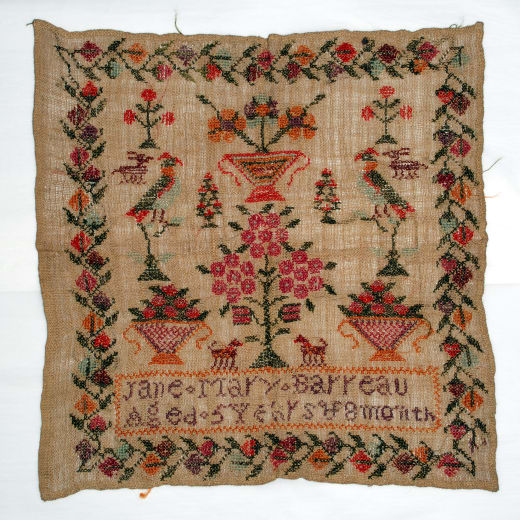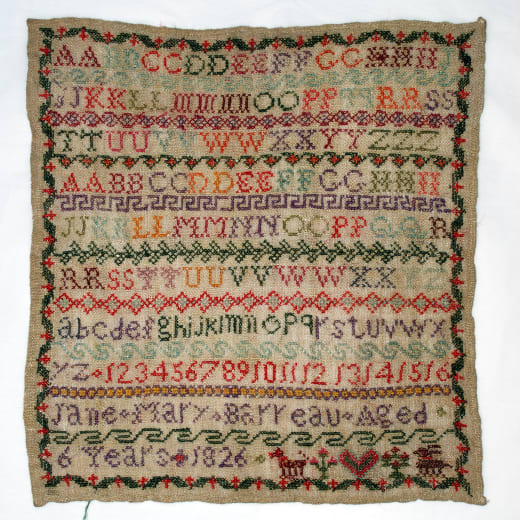
We have over 90 samplers in our textile collection, the oldest of which dates from 1736 and the most recent 1943.
A sampler is essentially a piece of embroidery that was produced, usually by young girls, as a demonstration or test of their skill in needlework. They often include the alphabet, numbers, motifs, decorative borders and sometimes a verse and the name of the person who worked it and the date. Today, samplers are often simply seen as nostalgic decorative pieces associated with interior design but in reality their historical role is much more than that.
The name ‘sampler’ is derived from the Medieval French word essamplaire, meaning a kind of model or pattern to copy or imitate. Before printed pattern books became available the only way embroidery designs could be transmitted was by being passed from hand to hand. Whenever a woman saw a new or interesting pattern she would sew a small copy onto a piece of cloth as a reminder, and in this way patterns spread throughout Europe and the Middle East. This method of recording patterns and motifs on fabric for future use was an essential method of storing information, which meant that new patterns were collected and exchanged with successive embroiderers adding their own colours and interpretation. This collecting of patterns accelerated in the late fifteenth and sixteenth centuries when there was a strong interest in all forms of decoration and it became fashionable for needlework to decorate clothing and furnishings and the growing interest in travel and exploration resulted in exchanges of techniques, materials and dyes. By the end of the sixteenth century needlework had gained importance as it displayed wealth and status and samplers continued to be made as practice pieces and for reference.
The earliest reference to a sampler in England appears in 1502 in the household expense accounts of Henry VII’s wife, Elizabeth of York. The records show that on 10 July of that year, Thomas Fisshe was paid for ‘an elne of Iynnyn cloth for a sampler for the Quene’. The earliest surviving sampler is in the V&A collection and was signed by Jane Bostocke and dated 1598.
We have over 90 samplers in our textile collection, the oldest of which dates from 1736 and the most recent 1943. The majority of the collection dates from the 19th century. Most have been worked by girls between the ages of 5 and 11 but unusually, there are 4 worked by boys, 3 of whom were from the Gossett family. Many have the same border pattern of roses and leaves suggesting the same needlework teacher but show some very different levels of skill!
In most cases the samplers are signed and dated, so they are an interesting addition to family history research. That a piece of embroidery worked by a child more than 200 years ago can still exist can be a very exciting find and can bring our ancestors to life in a very real way.
These samplers are worked by Jane Mary Barreau and are two of five samplers worked by her in our collections, all of which are dated 1826. Three of these state that she was aged six when she completed them and two show she was 5 years and 8 months old. It is an extraordinary body of work for such a young child. The samplers are all very neatly done; three are simple band samplers of alphabets and numbers, whilst the other two are more pictorial.
Jane Mary Barreau was born in 1820 to a Barnabé Barreau and a Jeanne Gallichan. Jane Mary Barreau’s brother Francois married Elizabeth Hamptonne and we also have two of her samplers in the collection. Francois and Elizabeth Barreau were the parents of Emmeline Augusta Barreau, who contributed the funds to open the Barreau Art Gallery at Jersey Museum in the 1920s.










